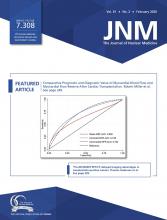TO THE EDITOR: George de Hevesy was a Hungarian radiochemist who was awarded the Nobel Prize in Chemistry in 1943 for the discovery of the radiotracer principle (1). As the radiotracer principle is the foundation of all diagnostic and therapeutic nuclear medicine procedures, Hevesy is widely considered the father of nuclear medicine (1). Although it is well-known that he spent time at several European institutions, it is not widely known that he also spent 6 wk at Cornell University in Ithaca, New York, in the fall of 1930 as that year’s Baker Lecturer in the Department of Chemistry (2–6). “[T]he Baker Lecturer gave 2 formal presentations per week, to a large and diverse audience and provided an informal seminar weekly for students and faculty members interested in the subject. The lecturer had an office in Baker Laboratory and was available to faculty and students for further discussion” (7). There is also evidence that, “…Hevesy visited Harvard [University, Cambridge, MA] as a Baker Lecturer at Cornell in 1930…” (8).
George de Hevesy
Neither of the authors of this Letter to the Editor was aware of Hevesy’s association with Cornell University despite our longstanding ties to Cornell until one of us (William. C. Klingensmith) noticed the association in Hevesy’s biographic page on the official Nobel website (6). Klingensmith obtained both his undergraduate degree and his medical degree from Cornell in Ithaca and New York City, respectively, and spent his career in nuclear medicine. Joseph R. Osborne did his nuclear medicine training at Columbia University and has subsequently been a faculty member of Weill Cornell Medical College for the last 11 y (with a brief tenure at Memorial Sloan Kettering Cancer Center [affiliated with Cornell]) and is now the program director of the Nuclear Medicine residency and Chief of the Molecular Imaging and Therapeutics Section.
George de Hevesy spent time at an unusually large number of European universities. This fact is sometimes attributed to his family wealth, which allowed him to choose his research environment, but the Nazi takeover of Germany and adjacent countries was also a factor. Here is a brief chronologic list of universities that Hevesy was associated with including selected details: Piarista Catholic Grammar School (graduated in 1903, age 17, specialized in mathematics and physics); University of Budapest (1 y of college); Berlin’s Technical University (to study chemical engineering; contracted pneumonia and was advised to move to a university with a warmer climate); University of Freiburg (completed his doctorate degree in 1908); Technical University of Zurich, Switzerland (postdoctoral assistant; Albert Einstein arrived a year later); Karlsruhe, Germany, (worked with famous chemist Fritz Haber); University of Manchester, Manchester, England (1911, worked with Ernest Rutherford; discovered radiotracer principle at age 27, which led to a Nobel Prize); University of Budapest (1918, professor of physical chemistry); University of Copenhagen (1920, worked with Niels Bohr; began study of biologic systems with radiotracers; co-discoverer of element 72, Hafnium [Hafnia is Latin for Copenhagen]); University of Freiburg (1926, professor of physical chemistry); Cornell University (1930, Baker Lecturer); University of Freiburg (Hevesy loved the city of Freiburg); University of Copenhagen (1934, back to Copenhagen because of Nazi takeover in Germany); Institute of Research in Organic Chemistry, Stockholm, Sweden (1944, became dangerous to remain in Copenhagen because of the Nazis; being a Nobel Laureate allowed him to become a Swedish citizen); and University of Stockholm (in his retirement, he remained an active scientific associate of the University of Stockholm) (1). Hevesy was associated with 8 European universities, several more than once, and 1 American university, Cornell University.
One reason that Hevesy’s association with Cornell may be easily overlooked is that he is not included in the list of 50 Nobel Prize winners associated with Cornell University (9,10). A detailed general analysis of Nobel Laureates associated with universities can be found on Wikipedia (11). The analysis states that, “The official academic affiliations fall into 3 categories: 1) Alumni (graduate & attendee), 2) Long-term academic staff, and 3) Short-term academic staff.” Short-term academic staff is defined as, “all employment-based visiting positions, which carry teaching/research duties, are included as affiliations in the list.” Cornell requires that the individual conduct research at the University, not just teaching (Brian Crane, written communication, June 2019). Of interest, since its inception in 1927, 26 of the 99 Baker Lecturers (26%) have won a Nobel Prize.
In 1958 Hevesy became an honorary member of the U.S.-based Society of Nuclear Medicine and Molecular Imaging (formerly Society of Nuclear Medicine). In 1960, the Society of Nuclear Medicine initiated the George Charles de Hevesy Nuclear Pioneer Award in conjunction with the Hevesy Nuclear Medicine Pioneer Lecture; this is the most prestigious award given by the Society of Nuclear Medicine and Molecular Imaging (12).
Footnotes
Published online Jul. 13, 2019.
- © 2020 by the Society of Nuclear Medicine and Molecular Imaging.








